21.07.2021
ExoMars orbiter continues hunt for key signs of life on Mars

TheESA-Roscosmos Trace Gas Orbiter has set new upper limits on how much methane, ethane, ethylene and phosphine is in the martian atmosphere – four so-called ‘biomarker’ gases that are potential signs of life.
Searching for biomarkers on Mars is a primary goal of the ExoMars Trace Gas Orbiter. A key biomarker of interest is methane, as much of the methane found on Earth is produced by living things or geological activity – and so the same may be true for Mars.
The ‘methane mystery’ on Mars has been ongoing for many years, with contradictory findings from missions including ESA’s Mars Express and NASA’s Curiosity rover capturing sporadic spikes and bursts of the gas in Mars’ atmosphere, fluctuations both in orbit and at the planet's surface, signs of the gas varying with the seasons, or not observing any methane at all.
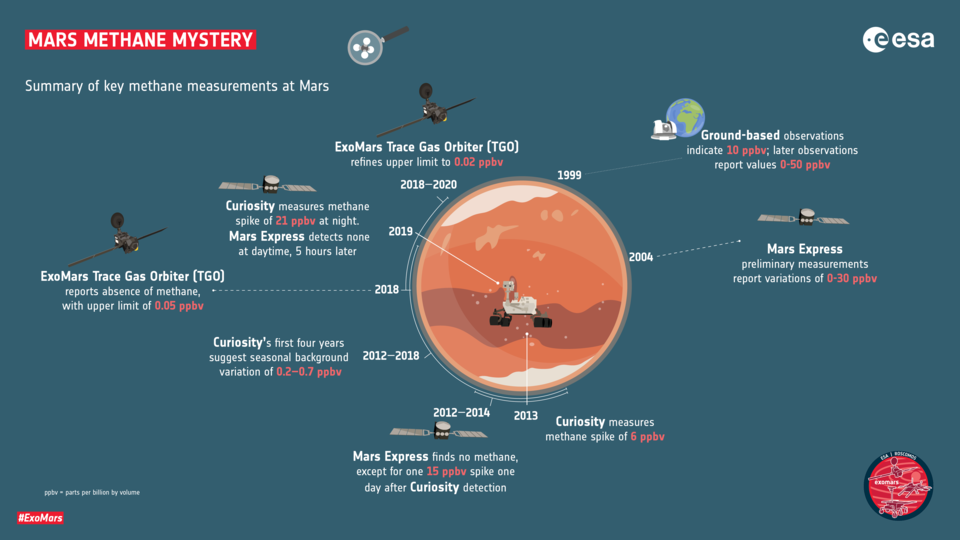
Previous estimates from Mars and ground-based missions range from 0.2 up to 30 parts per billion by volume (ppbv), indicating up to 30 molecules of methane per billion molecules. For reference, methane is present in Earth’s atmosphere at nearly 2000 ppbv.
However, the first results from the Trace Gas Orbiter, reported in April 2019, spotted no methane, instead calculating that, if present, the gas must have a maximum concentration of just 0.05 ppbv.
“We have now used the Trace Gas Orbiter to refine the upper limit for methane at Mars even further, this time gathering data for over 1.4 martian years – 2.7 Earth years,” says Franck Montmessin of LATMOS, France, Co-Principal Investigator of the Trace Gas Orbiter’s Atmospheric Chemistry Suite (ACS) and lead author of one of a trio of new papers on martian biomarkers.
“We found no sign of the gas at all, suggesting that the amount of methane at Mars is likely even lower than previous estimates suggest.”
As the orbiter’s instruments are highly sensitive, if methane is present it must be at an abundance of less than 0.05 ppbv – and more likely less than 0.02 ppbv, say Franck and colleagues. The scientists also hunted for signs of methane around Curiosity’s home, Gale crater, and found nothing, despite the rover reporting the presence of methane there.
“Curiosity measures right at Mars’ surface while the orbiter takes measurements a few kilometres above – so the difference between these two findings could be explained by any methane being trapped to the lower atmosphere or the immediate vicinity of the rover,” adds Franck.
The apparent lack of martian methane reported by Franck and colleagues is supported by a paper using data from the orbiter’s NOMAD (Nadir Occultation MArs Discovery) instrument, again spanning a full martian year and searching for methane and two other biomarkers.
“We also found no sign of methane on Mars, and set an upper limit of 0.06 ppbv, which agrees with TGO’s initial findings using ACS,” says the paper’s lead author Elise Wright Knutsen, previously at NASA’s Goddard Space Flight Center, USA, and now at LATMOS, France. “As well as searching for global methane, we also looked for localised plumes at over 2000 locations on the planet and didn’t detect anything – so if methane is released in this way, it must be sporadic.”

Alongside methane, Elise and colleagues looked for two other potential biomarker gases: ethane and ethylene. These molecules are expected to occur after methane is broken down by sunlight, and so are exciting both in their own right and in the context of our hunt for methane. Ethane and ethylene molecules also have short lifetimes, meaning that if they are found in a planetary atmosphere they must have been recently released or created via an ongoing process. This makes them excellent tracers of possible biological or geological activity.
“These are ExoMars’ first results hunting for these two gases,” says Elise. “We didn’t detect either, and so set upper limits for ethane and ethylene at 0.1 and 0.7 ppbv, respectively – low, but higher than our limits for methane.”
The orbiter has also been hunting for phosphine – a gas that caused a splash and huge controversy last year when it was allegedly detected at Venus. Most phosphine on Earth is biologically produced, making it an exciting biomarker in the atmospheres of terrestrial planets.
“We didn’t find any signs of phosphine at Mars,” says Kevin Olsen of the University of Oxford, UK, and lead author of the phosphine study. “Our upper limits are similar for those of ethane and ethylene – between 0.1 and 0.6 ppbv.”
The search for life on Mars, or lingering signatures of it, is a central goal of the ExoMars programme, and the hunt for biomarkers in particular is a primary goal of the Trace Gas Orbiter. The forthcoming ExoMars rover Rosalind Franklin, due for launch in 2022, will complement TGO’s hunt for biomarkers by digging down into the martian surface; underground samples may be more likely to retain biomarkers, as material is shielded from the harsh radiation environment of space.
“Whether biomarkers are detected or not, these findings are important for our understanding of which processes occur, and which do not, in the martian atmosphere – essential information when considering where to focus our continued investigation of Mars,” adds Håkan Svedhem, ESA Project Scientist for the ExoMars Trace Gas Orbiter.
“Many key questions remain – for instance, why does Curiosity see methane at Gale Crater, while we find none in orbit? Could this methane have come from elsewhere, or only be found in particular locations across the planet – or could an unexpected process be destroying any methane present before we can detect it?
It will be exciting to continue working collaboratively with missions like the Curiosity and Rosalind Franklinrovers, both of which have totally different vantage points to an orbiter, to really pin down what is happening in this mysterious planetary environment.”
Quelle: ESA
----
Update: 4.08.2021
.
Science in motion for ExoMars twin rover

The first science tests for the ExoMars rover replica kicked off after several weeks of driving tests around the Mars Terrain Simulator at the ALTEC premises in Turin, Italy.
With the locomotion system up and running, it is time now for the rover’s cameras and instruments to scan a Mars-like terrain – both on and under the surface – in search for the best samples.
The twin of ESA’s Rosalind Franklin rover, also known as The Ground Test Model (GTM), has been busy surveying 64 square metres of terrain in one of Europe’s largest Mars yards, carefully staged with sandy areas and rocks of various sizes, as well as gravity and light simulations to recreate the environment on Mars.
See, snap, survey
Imaging comes first. Two stereo cameras at the top and at the bottom of the rover’s mast – NavCam and LocCam – allow the GTM to ‘see’ in three dimensions and identify the rocks and slopes ahead. The cameras guide the rover through safe paths and help avoid hazards.

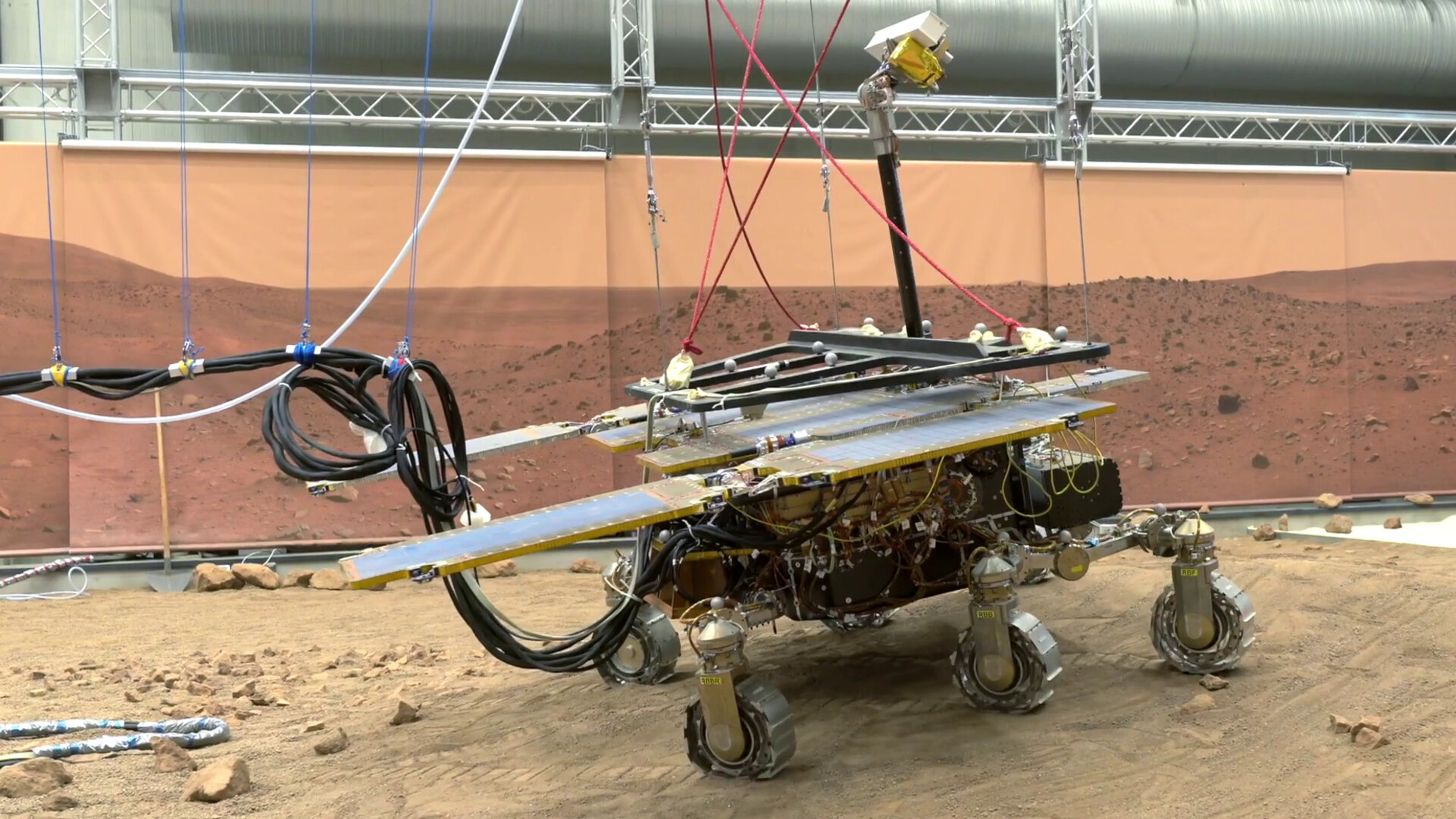
Access the video
Once the rover is on the move, two more sets of cameras – PanCam and CLUPI – come into play to get a whole picture of the site with high resolution imaging. These rover ‘eyes’ send panoramic and close-up images of the terrain to the operators at the Rover Operations Control Centre (ROCC). Teams from Thales Alenia Space and ALTEC worked in synergy with ESA engineers.
The images are essential to map the geological context and to help the scientists decide where the rover should stop and survey the surface in more detail.
Choosing the target

Finding suitable samples involves a lot more than just spotting an outcrop and digging. The rover is equipped with a ground penetrating radar – WISDOM – and a neutron detector – ADRON– to understand what lies beneath the surface.
The search for evidence of life on Mars is a main objective of the ExoMars 2022 mission.

If anywhere on Mars, traces of past or present life are most likely to be found underground, where ancient biological signatures may still be preserved from the harsh radiation on the Red Planet.
Much as archaeologists on Earth excavate sites, WISDOM can work by analysing the area in a grid fashion – by breaking the ground into small squares. The neutron spectrometer in ADRON will work in tandem with the radar to detect water and hydrated minerals below the surface.
Test cases for Mars
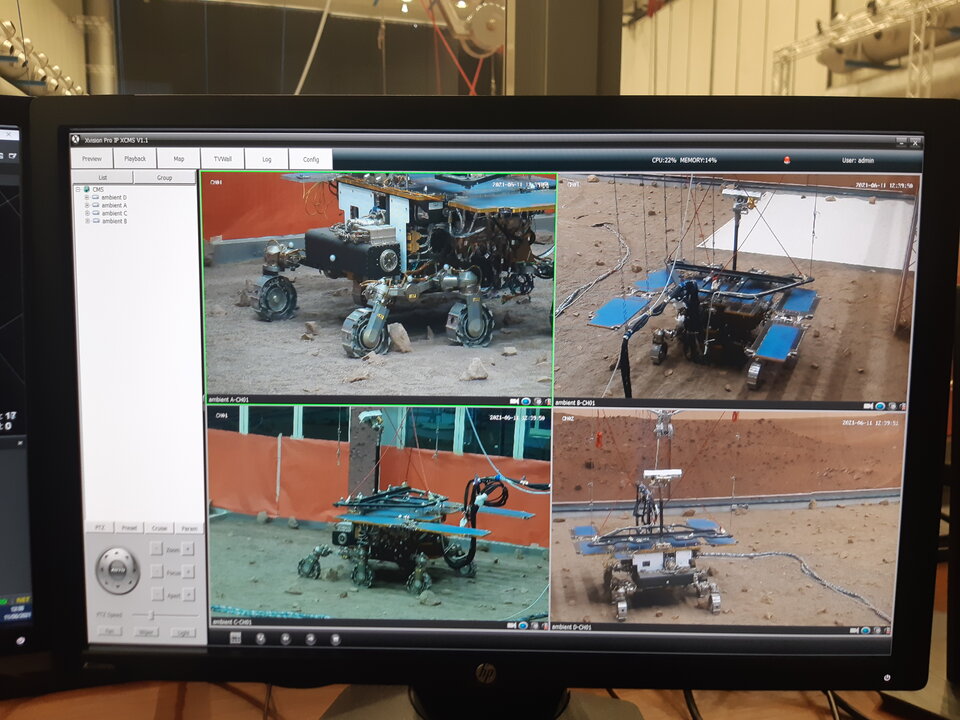
Operators are rehearsing all possible mission scenarios to prepare for Rosalind Franklin’s arrival in Oxia Planum on Mars in June 2023.
The first tests with science in action started with the rover doing a traverse to characterise a sandy and flat area. After roving for a while, the cameras fed the operators with stereo and high-resolution images.
Once a location deemed intriguing enough to drill for samples is found, it was time to get more information from beneath the surface.
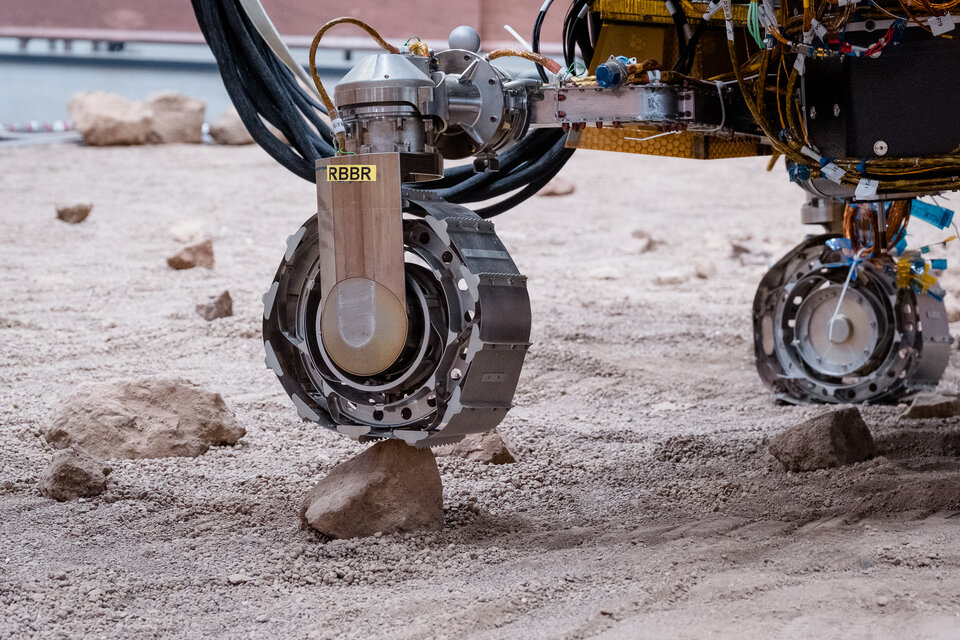
The ground penetrating radar WISDOM ran its science analysis every 10 cm for 30 seconds. Once the wheeled lab covered five metres, it performed two turns of 90 degrees and started all over again on a new five-metre track. At the end of the test, WISDOM scanned a grid of 25 square metres.
A second test repeated this sequence, this time around with a much longer drive of eight metres for a more far-reaching science acquisition. And instead of stopping every half a metre, the GTM used WISDOM every metre.
In both cases, the sequence was completed by the neutron detector, Adron, which took measurements looking for traces of water. Next up was the execution of a complete WISDOM grid of 25 square metres.
Where to drill?
These dry runs simulate the sequences the rover will follow on Mars, where the scientists will need to decide which area is worth drilling. Rosalind Franklin is fitted with a drill to extract samples down to a maximum of two metres, deeper than any other rover and a first in Mars exploration.
As a bonus during this first science dry run, the rover attempted some drilling at various depths and through a layer of sample material selected by the ExoMars team.
On Mars, the sample collected by the drill will be crushed into a fine powder and delivered to the analytical laboratory at the heart of the rover to analyse its mineralogy and chemistry.
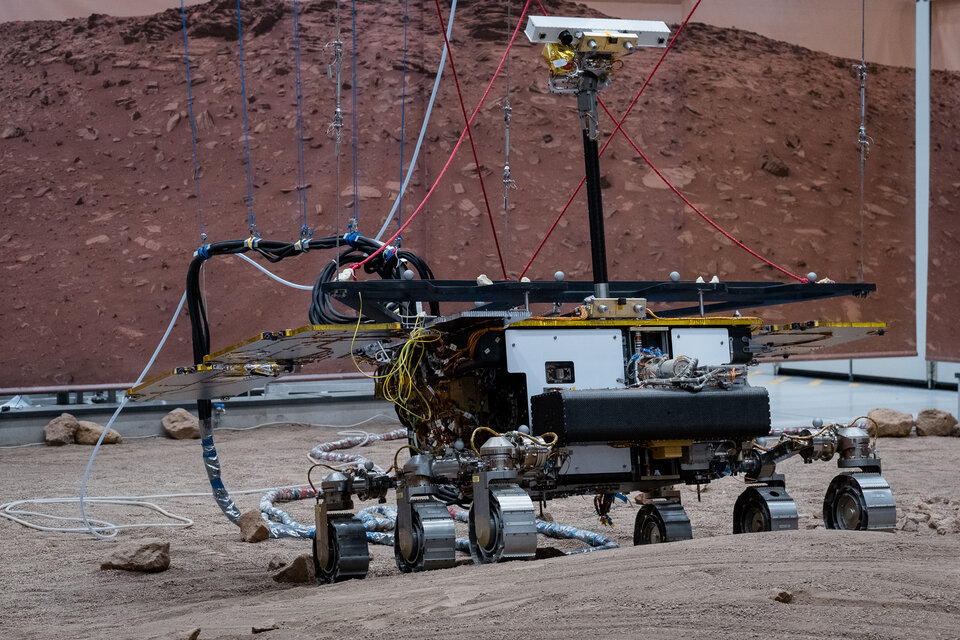
With no summer break for the rover, upcoming tests at the Mars Terrain Simulator will involve the analysis of samples inside the rover’s analytical lab. A suite of instruments – MicrOmega, Raman and MOMA – will study the mineralogical and molecular composition of the soil.
During the real mission to the Red Planet, the results of this analysis could answer questions about the potential origin, evolution and distribution of life on Mars
Quelle: ESA
----
Update: 23.08.2021
.
ExoMars 2022 mission in final testing, ESA & Roscosmos prepare for approaching launch

The European Space Agency (ESA) and Roscosmos are preparing for the 2022 launch of the next mission in their joint ExoMars program, which is currently undergoing final testing before shipment to Kazakhstan for a launch in September next year.
The 2022 astrobiology mission will see the long-awaited Rosalind Franklin rover land on Mars with the help of the Russian Kazachok lander. The lander will also perform experiments on the Martian surface after deploying Rosalind Franklin as the two craft work together to search for signs of past life on the Red Planet.
ExoMars 2022 in final testing
After construction delays, missed Martian transfer windows, and the COVID-19 pandemic, Rosalind Franklin, Kazachok, and the other ExoMars 2022 mission systems have been completing important testing milestones ahead of shipment to Kazakhstan for launch on a Proton rocket next year.
Multiple unsuccessful parachute drop tests in 2019 and 2020 led engineers to redesign the system multiple times, leading to successful drop and deployment tests on June 24 and June 25, 2021. The new parachute design, if proven safe in additional tests, will be used to slow Kazachok and Rosalind Franklin during their descent to the Martian surface.
While testing of Rosalind Franklin and its associated landing systems has progressed, a test rover called the “Ground Test Model” (GTM) has been used by ESA to examine surface operations, science instruments, and terrain climbing/movement.
Testing with the GTM is performed at ALTEC in Turin, Italy. ESA teams have conducted testing with the rover’s NavCam, LocCam, PanCam, and CLUPI camera instruments, which will be used by Rosalind Franklin to traverse the Martian terrain.
Alongside the four camera instruments, ESA has also tested a variety of instruments that will be essential for collecting samples, drilling into Mars, and roving across challenging terrain. Instruments like WISDOM, MicrOmega, Raman, MOMA, and the large drill will all be extensively tested on the GTM to prepare ESA teams for the mission.
Outside of ALTEC, ESA has also completed balance testing with the entire ExoMars 2022 mission stack at Thales Alenia Space’s cleanroom facilities in Cannes, France.
To stay on a nominal trajectory during its journey to Mars, the ExoMars 2022 spacecraft, comprised of the carrier module, descent module (backshell and heatshield), Kazachok lander, and Rosalind Franklin rover, will spin at a constant rate of 2.75 revolutions per minute.
Balance testing ensures there is nothing inside and outside of the spacecraft that could cause it to move or “wobble” off course.
Rosalind Franklin and Kazachok are currently expected to ship to the Baikonur Cosmodrome in the coming months. Once there, they will undergo final launch preparations, including encapsulation and mating with the Proton carrier rocket.
Rosalind Franklin and Kazachok
In 2001, ESA began the ExoMars program with a plan to send a rover to Mars in 2009 and a follow-on Mars Sample Return mission in the years following.
This original vision for ExoMars would ultimately be canceled; however, in 2009, the Russian Federal Space Agency and ESA signed a contract to work together on two separate Mars exploration missions. At the time, Russia was planning to send their Fobos-Grunt mission to Martian moon Phobos. That mission would launch in 2011, with an upper stage failure stranding it in low Earth orbit before destructive reentry.
In April 2011, the MAX-C rover, another ExoMars rover being developed alongside the ExoMars rover (now Rosalind Franklin) by ESA, was officially canceled, and it was decided that only one rover would be sent to Mars.

Concept art showing the preliminary design of the canceled MAX-C rover. (Credit: Lisa Pratt, Dave Beaty, Joy Crisp, Scott McLennan)
The ExoMars rover was to be developed by ESA and feature a multitude of instruments from other agencies, companies, and ESA partners. At the time, NASA was set to participate in the rover’s development and operations on Mars, but the FY2013 budget terminated NASA’s participation in ExoMars.
After Roscosmos became a full partner with ESA, the final ExoMars plan was laid out. The Trace Gas Orbiter, which had been part of ExoMars for several years, was to be launched before the ExoMars rover and lander — both of which would be primarily developed, constructed, and tested by ESA, with Roscosmos providing two Proton launches and several instruments for the spacecraft.
In March 2014, with a launch scheduled for 2018, the British division of Airbus Defense and Space, the builder of the rover, began acquiring critical components for its construction. Funding for the ExoMars rover was approved by ESA member states in December 2014.
During this time, the development and construction of the Russian Kazachok lander also began. Kazachok, set to be the descent vehicle that will carry and land Rosalind Franklin on the surface, will host 13 instruments that will study the surface environment at the landing site.

Rosalind Franklin preparing to roll off the top of Kazachok shortly after landing. (Credit: ESA)
In 2016, with the planned 2018 launch date creeping closer, ESA was struggling with scientific payload deliveries, and other goals for the mission were missing deadlines as well. Due to these issues, the ExoMars team announced they would be delaying the launch to July 2020.
As construction of the rover continued, one critical component of the rover was still missing — the name.
In summer 2018, ESA launched a public campaign to select a name for the rover. After reviewing submissions from the public, ESA announced on February 7, 2019, that the rover would be named Rosalind Franklin, a famed female scientist who researched and provided key contributions to the understanding of molecular structures in viruses, RNA, DNA, and more.
Following construction, the rover and Kazachok began an extensive testing campaign; however, in 2020, the COVID-19 pandemic forced work on the rover and lander to come to a halt, leading teams to miss critical deadlines needed to launch in 2020. As a result, the launch was delayed to 2022.

The GTM (Ground Test Model) explores the terrain of ESA’s Mars yard in Italy. (Credit: Thales Alenia Space)
The nine instruments Rosalind Franklin will carry include the Panoramic Camera (PanCam), Infrared Spectrometer for ExoMars (ISEM), Water Ice Subsurface Deposits Observation on Mars (WISDOM), Adrom-RM, Close-Up Imager (CLUPI), Mars Multispectral Imager for Subsurface Studies (Ma_MISS), MicrOmega, Raman Laser Spectrometer (RLS), and Mars Organic Molecule Analyzer (MOMA).
Kazachok will carry 13 total instruments. These include the Lander Radioscience experiment (LaRa), Habitability, Brine, Irradiation and Temperature (HABIT), meteorological package (METEO-M), MAIGRET, Wave Analyzer Module (WAM), TSPP, interface, and memory unit (BIP), IR Fourier spectrometer (FAST), Active Detection of Radiation of Nuclei-ExoMars (ADRON-EM), multi-channel Diode-Laser Spectrometer for atmospheric investigations (M-DLS), radio thermometer for soil temperatures (PAT-M), dust particle size, impact, and atmospheric charging instrument suite (Dust Suite), seismometer (SEM), and the Gas chromatography-mass spectrometry for atmospheric analysis (MGAK) instruments.
The primary goal of ExoMars 2022 is to search for signs of past life, which the Trace Gas Orbiter (TGO) has been doing since 2016 from orbit. TGO “sniffs” the upper atmosphere of Mars for methane and other trace gases that could be evidence of past life.

The launch of the ExoMars 2016 mission with the TGO and Schiaparelli lander in March 2016. (Credit: ESA/Stephanie Corvaja)
ExoMars 2022 is scheduled to launch during a 12-day window in September 2022. Following liftoff, the ExoMars 2022 spacecraft (Rosalind Franklin, Kazachok, descent module, and carrier module) will coast through space for nearly eight months, waking up periodically to perform course correction burns and system health checks.
On June 10, 2023, the descent module will streak into the atmosphere of Mars and begin the entry, descent, and landing phase of the mission.
After entering the atmosphere, releasing the heatshield, dropping the rover and lander, lighting the lander’s engines, and touching down on the surface of Mars, Rosalind Franklin and Kazachok will begin surface operations.
ExoMars 2022 will launch on a Proton-M/Briz-M rocket from Baikonur Cosmodrome and is expected to land in the Oxia Planum region of Mars.
(Lead image: Artist’s impression of ESA’s Rosalind Franklin rover and Russia’s Kazachok lander. Credit: ESA/ATG medialab)
Quelle: NS
----
Update: 17.09.2021
.
First deep drilling success for ExoMars
ESA’s Rosalind Franklin twin rover on Earth has drilled down and extracted samples 1.7 metres into the ground – much deeper than any other martian rover has ever attempted.
The successful collection of soil from a hard stone and its delivery to the laboratory inside the rover marks a promising milestone for the ExoMars 2022 mission.
“The long-awaited success of the ExoMars drill on Earth would be a first in Mars exploration,” says David Parker, ESA’s director of human and robotic exploration. The deepest any drill has dug on the Red Planet to date is 7 cm.
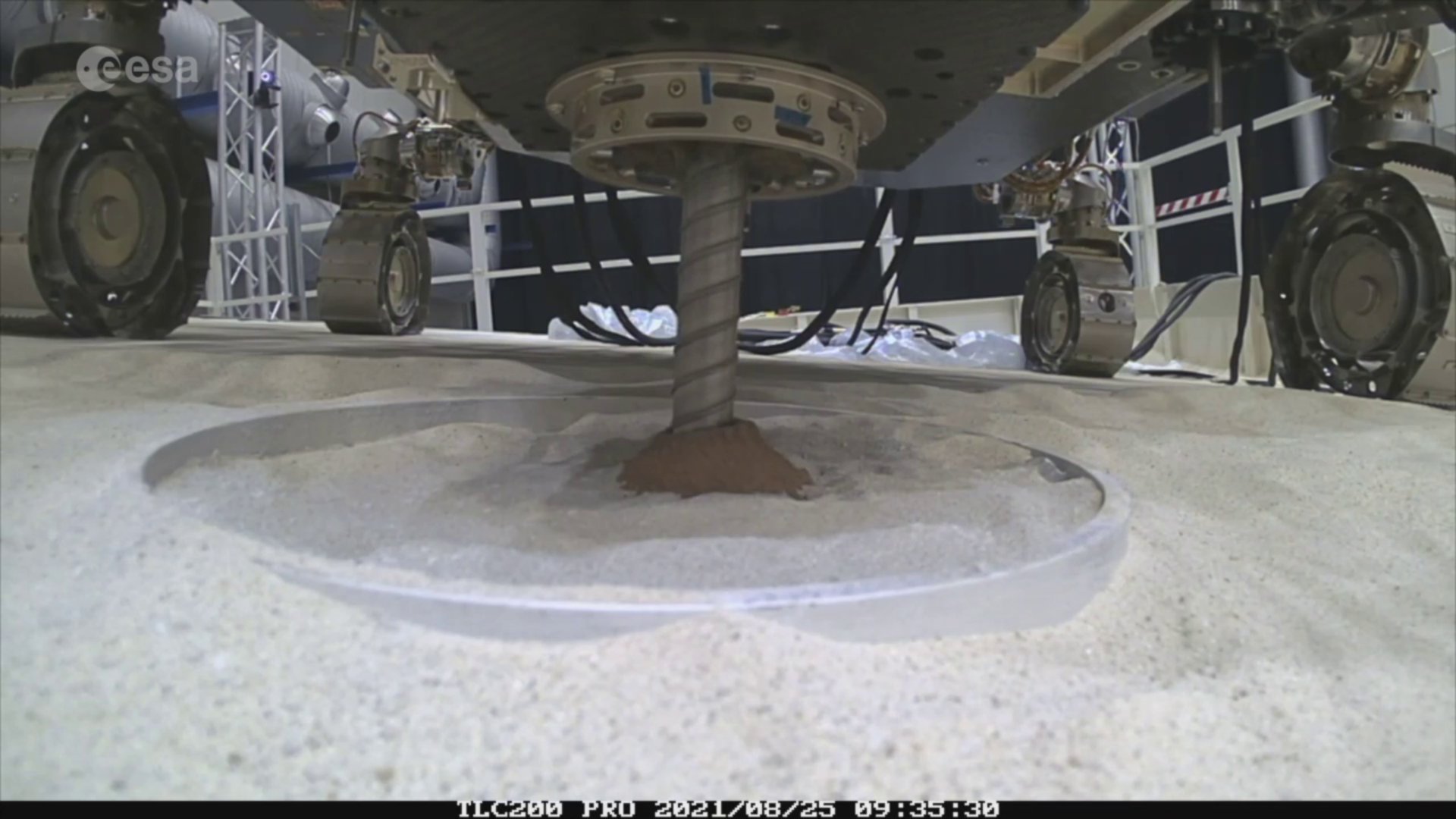
Access the video
The Rosalind Franklin rover is designed to drill deep enough, up to two metres, to get access to well-preserved organic material from four billion years ago, when conditions on the surface of Mars were more like those on infant Earth.
The replica, also known as the Ground Test Model, is fully representative of the rover set to land on Mars. The first samples have been collected as part of a series of tests at the Mars Terrain Simulator at the ALTEC premises in Turin, Italy. The drill was developed by Leonardo, while Thales Alenia Space is the prime contractor for ExoMars 2022.
Drill operations

Rosalind Franklin’s twin has been drilling into a well filled with a variety of rocks and soil layers. The first sample was taken from a block of cemented clay of medium hardness.
Drilling took place on a dedicated platform tilted at seven degrees to simulate the collection of a sample in a non-vertical position. The drill acquired the sample in the shape of a pellet of about 1 cm in diameter and 2 cm long.
Rosalind Franklin’s drill retains the sample with a shutter that prevents it from dropping out during retrieval. Once captured, the drill brings the sample to the surface and delivers it to the laboratory inside the rover.
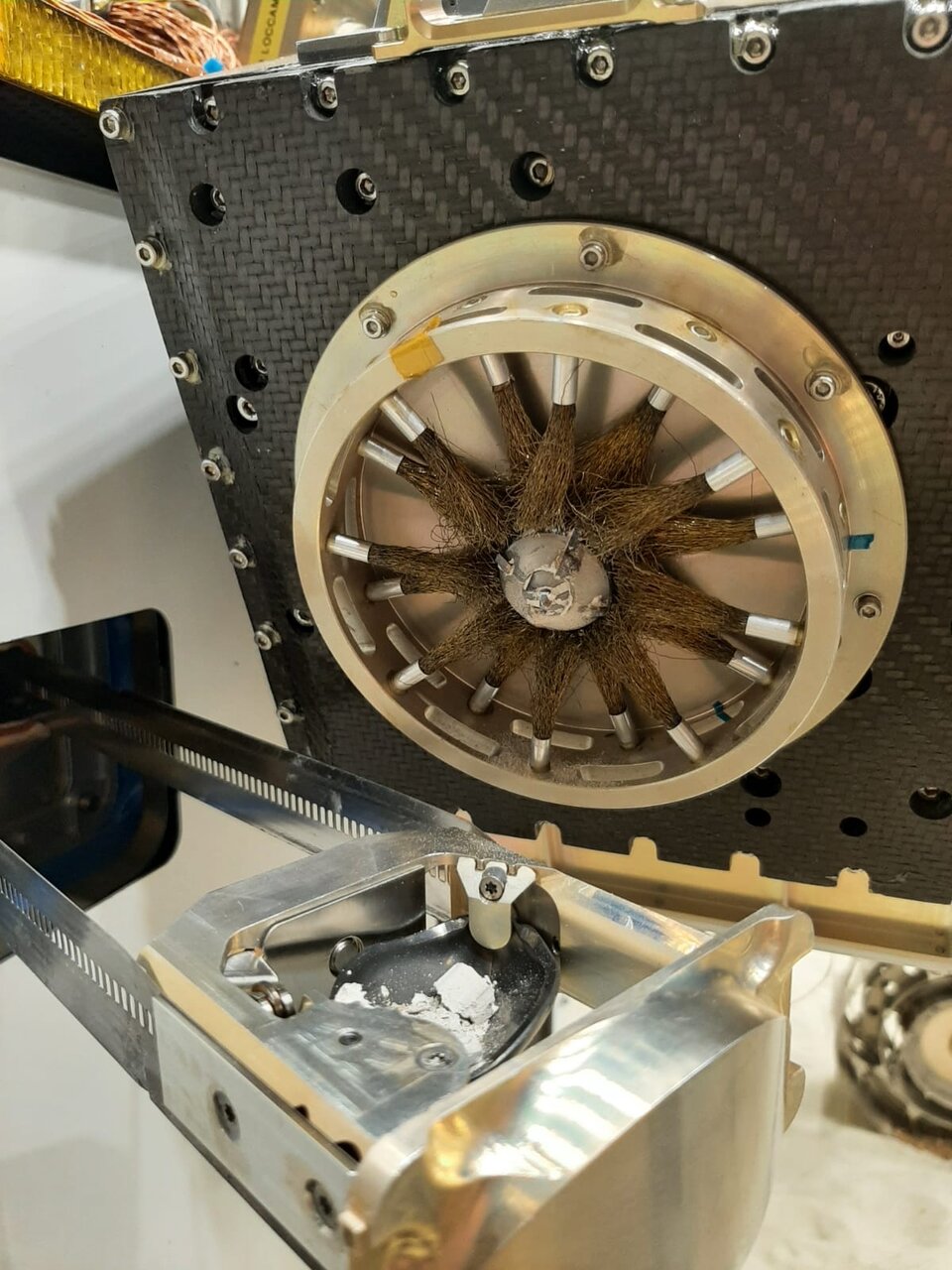
With the drill completely retracted, the rock is dropped into a drawer at the front of the rover, which then withdraws and deposits the sample into a crushing station. The resulting powder is distributed to ovens and containers designed to perform the scientific analysis on Mars.
“The reliable acquisition of deep samples is key for ExoMars’ main science objective: to investigate the chemical composition —and possible signs of life— of soil that has not been subjected to damaging ionising radiation,” says ExoMars project scientist Jorge Vago.
A unique drill for Mars
The ExoMars drill is an assembly of mechanisms that rely on an automated choreography of tools and mounting rods. “The design and construction of the drill has been so complex that this first deep drilling is an extraordinary achievement for the team,” says Pietro Baglioni, ExoMars rover team leader.
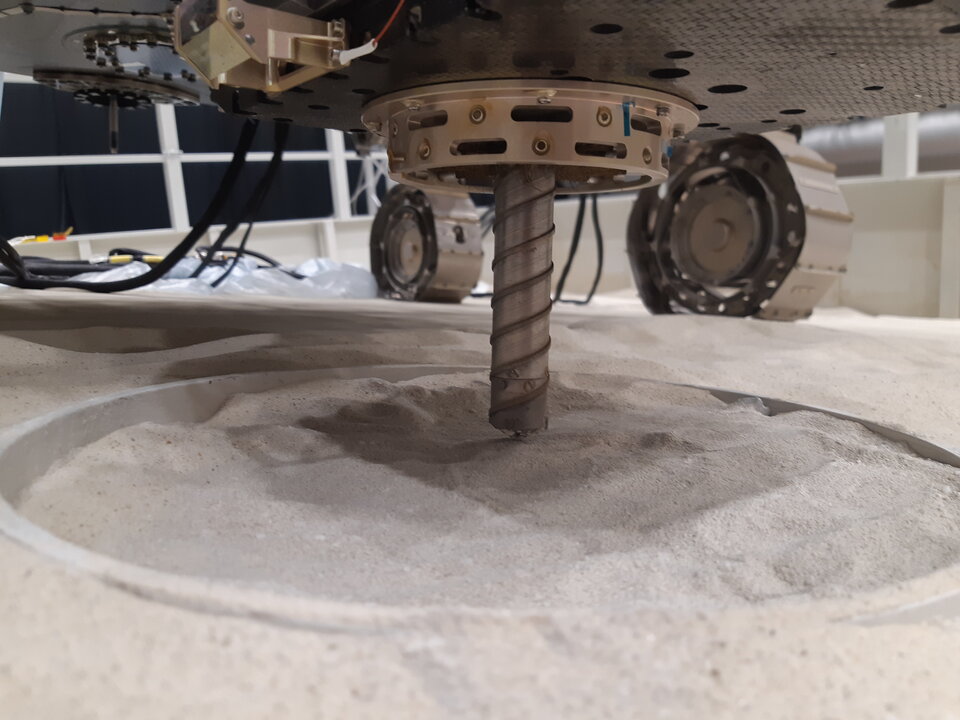
Rosalind Franklin’s drill works on rotation. A series of tools and extension rods are fitted to form a ‘drill string’ and can reach the full 2m length when all are connected.
The drill can penetrate the ground at 60 rotations per minute, depending on the consistency of the soil. Digging into sandy or clay solid materials could take between 0.3 and 30 mm per minute.
The drill has also a two-degree of freedom positioner that allows it to discharge the sample at the right angle into the rover laboratory.
No easy feat
“Drilling hard stones to a depth of two metres on a mobile wheeled platform with less than 100 watts of power is a complex task,” explains Andrea Merlo, ExoMars Rover functional engineer from Thales Alenia Space.
Doing it on Earth is even more difficult because the Ground Test Model must be offloaded to recreate the weaker martian gravity level – Mars gravity is about one-third of Earth’s. The model hangs from the ceiling on a dedicated gravity compensation device.

Since the twin rover consists of models that are beyond their nominal lifetime, the team had to tune some parameters during the deep drilling test. “This already gives engineers a hint on how the system could degrade on Mars,” adds Andrea.
Tests to roving on Mars
The Ground Test Model has successfully completed a number of tests to move to and to identify targets while acquiring images and data. These dry runs to rehearse the rover operations on Mars started in June 2021.

The rover has demonstrated that it can follow precise trajectories and survey the environment on and below the surface with its instruments, including cameras, spectrometers and a sub-surface sounding radar and neutron detector.
In parallel, the real Rosalind Franklin rover is being prepared for its flight to Mars in nearly a year’s time – the launch window for ExoMars opens on 20 September 2022.
Notes to editors
The ExoMars programme is a joint endeavour between ESA and Roscosmos. In Europe, The rover is a joint venture between Thales Alenia Space – Italia (67%) and Leonardo (33%). Thales is the industrial prime, Leonardo providing the drill, OHB the complex laboratory mechanisms and nine different instrument teams from ESA Member States, NASA/JPL and IKI/Roscosmos providing the payload. Astrium Ltd. (ASU) is responsible for the rover vehicle.
Quelle: ESA
----
Update: 8.11.2021
.
Smart focus on Mars

Two stereo cameras at the top and at the bottom of the rover's mast - NavCam and LocCam - allow the GTM to 'see' in three dimensions and identify the rocks and slopes ahead. The cameras guide the rover through safe paths and help avoid hazards. Once the rover is on the move, two more sets of cameras - PanCam and CLUPI - come into play to get a whole picture of the site with high resolution imaging. These rover 'eyes' send panoramic and close-up images of the terrain to the operators at the Rover Operations Control Centre (ROCC). The images are essential to map the geological context and to help the scientists decide where the rover should stop and survey the surface in more detail.
From panoramas to close-ups, from 3D maps to a wheel selfie, the Earth-bound twin of ESA's Rosalind Franklin rover is testing the wide range of photo settings that will deliver the greatest science possible during the ExoMars mission on the Red Planet.
The scientific eyes of the rover are set on the Panoramic Camera suite known as PanCam. The replica atop the mast of the Ground Test Model rover is achieving a level of detail similar to what is expected from Rosalind Franklin in 2023.
The target over the last few months has been the reddish and grainy, sometimes rocky surface of the Mars Terrain Simulator at the ALTEC premises in Turin, Italy.
"Since we will be looking for water and life on Mars, testing Rosalind Franklin's main cameras is particularly important in the search for water-rich minerals," explains Andrew Coates, PanCam principal investigator and Professor at the UCL Mullard Space Science Laboratory in the UK.
PanCam does not have just one pair, but three 'science eyes': one high-resolution and two wide-angle cameras. Their unique colour imaging allows for "water-rich mineral identification and outstanding 3D vision, way better than the human eyes. The views from PanCam will give us key insights on the martian landscape," adds Andrew.
Science on top
Engineers have packed as much science as they could into the camera system.
The two wide-angle cameras (WACs) are set 50 cm apart and form a stereo pair that images what is in front of the rover from a vantage point about two metres above the ground. Scientists create 3D pictures and depth maps by overlaying simultaneous snapshots.
"Besides plotting routes where the rover can go, these cameras help us do geology and atmospheric science," says Andrew.
The High Resolution Camera (HRC) has eight times the resolution of the wide-angle cameras to closely examine rock texture and grain size in colour.
This powerful camera "will help us investigate very fine details in outcrops, rocks and soils, find the most promising spots to drill, and take images of the samples before they are sent to the rover's laboratory," says Nicole Schmitz, PanCam co-principal investigator responsible for the high-resolution camera at the DLR Institute of Planetary Research, Germany.
Mounted below is the infrared spectrometer (ISEM) that analyses the geochemistry of the rocks. HRC and ISEM are a well-matched couple. They are co-aligned, so that scientists can see in the HRC images where ISEM took its measurements.
Rainbow eyes
Humans and smartphones can only see colours in visible light. PanCam can 'see' in 19 colours, in the visible and near infrared wavelengths.
Each of the wide-angle cameras has a filter wheel with 11 positions to look at the colours of the rocks and the martian sky.
This special carousel will allow the rover to stare at the Sun, find the amount of dust in the atmosphere and measure the water vapour content during sunsets on Mars.
A calibration target mounted on the rover's solar array top deck, comprising a palette of stained glass similar to that of church windows, will help PanCam get its colours right.
Mars-proof
PanCam can withstand much harsher conditions than smartphone cameras on Earth. The hardware can cope with extreme temperatures, from zero degrees during the day down to -120 degrees Celsius during the cold martian nights. The sensors are also resistant to the high radiation environment during the journey to Mars and on the surface of the planet.
"It was challenging to build a robust enough camera with adjustable focus to take high resolution images of very close and far away targets," says Nicole.
Rosalind Franklin can also take a look at herself - a small spherical mirror close to one of the rover's wheels can be used to get a view underneath the rover. The Rover Inspection Mirror, mounted near a rover wheel, will enable PanCam to capture images from underneath the rover.
There is yet another camera which will come in to play for martian shots in upcoming tests. The Close-Up Imager, CLUPI, will provide detailed views of the soil that is churned out by the drilling action. When the drill is in 'stowed' position this camera can also take photos of the landscape to the side of the rover.
Quelle: SD
----
Update: 19.01.2022
.
Steady driving towards ExoMars launch

The first simulation of the ExoMars rover driving off its landing platform closed out an incredible year of preparations as the mission now marches with confidence towards a September launch.
ESA’s Rosalind Franklin rover starts the year with months of successful maintenance and functional tests behind it. All its instruments are go for flight, with some minor tuning left to complete this month.
“The rover is ready, and together with the recent drop test success for the parachutes, we are positive to be in time for the September launch date,” says Pietro Baglioni, ESA’s ExoMars rover team leader.
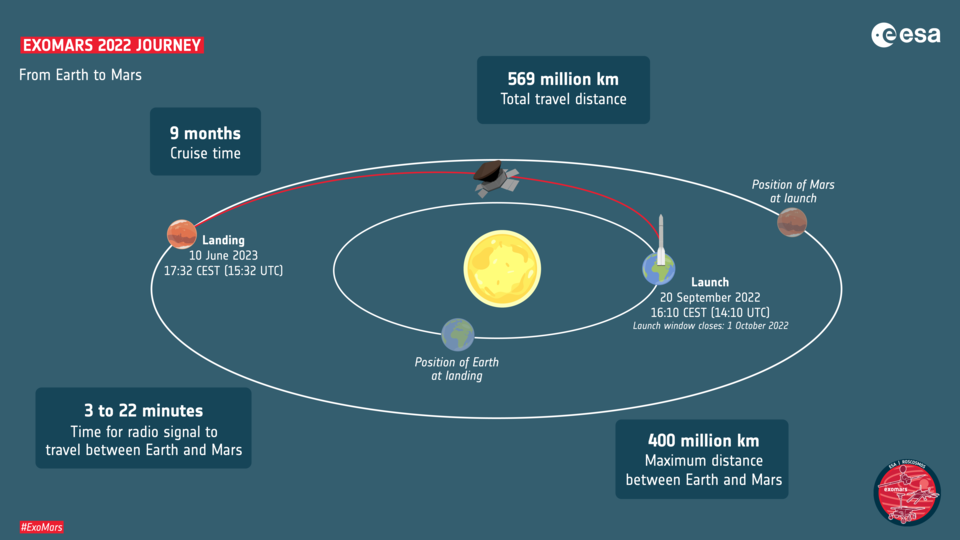
Only once every two years and for about ten days, celestial mechanics would allow the spacecraft to reach Mars from Earth in the shortest possible time – around nine months.
Rosalind now sits in an ultra-clean room at the Thales Alenia Space premises in Turin, Italy, right by its travelling companion, the Kazachok landing platform. Following a final review at the end of March, all the components of the spacecraft – rover, descent module, landing platform and carrier – will move to the launch site in Baikonur, Kazakhstan, to prepare for lift-off.
“Just before that last trip on Earth, we will upload the final version of the software that will allow the rover to scout Mars autonomously,” explains Pietro.
First martian moves
Following the nerve-wracking descent to the surface of Mars, a long-awaited moment in the ExoMars mission will be when Rosalind leaves the landing platform and drives onto the martian soil for the first time. The egress from Kazachok is a carefully choreographed move that engineers are rehearsing on Earth.

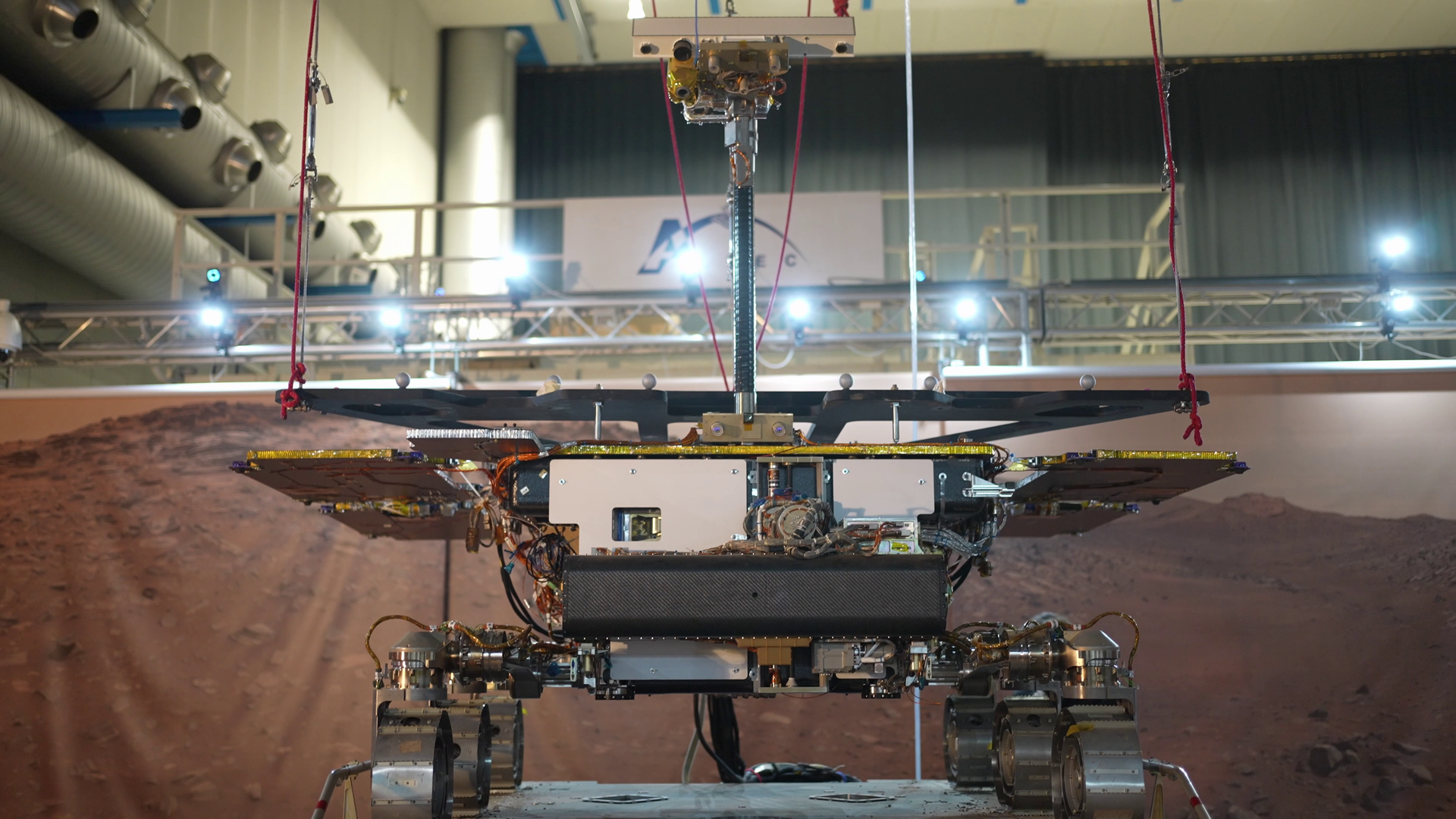
Access the video
The twin of ESA’s Rosalind Franklin rover has successfully left the platform during recent tests in a Mars terrain simulator at the ALTEC premises in Turin.
While the driving during these exercises takes about 15 minutes, the whole process will last a few martian days. After landing, the rover will be busy for over a week unfolding its wheels and deploying the mast, among other checkouts.
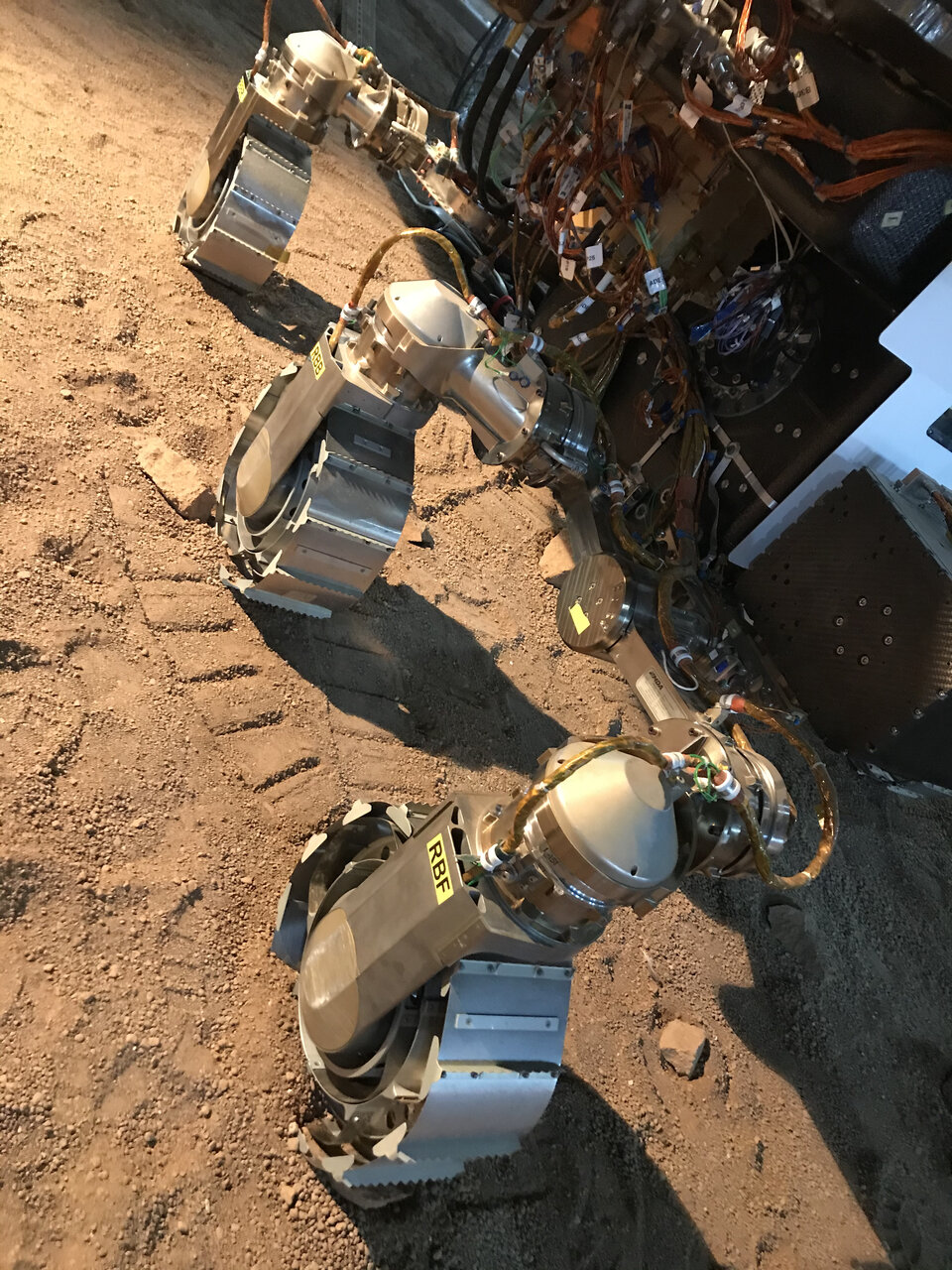
“The egress is a long and crucial operation. We need to be gentle and run it in a very slow motion for extra safety,” explains Andrea Merlo, ExoMars head of robotics from Thales Alenia Space.
The landing platform has two exit ramps: one at the front and another one at the back. Rosalind is designed to negotiate steep inclines on the ramps, but it is up to ground control on Earth to decide which is the safest way to drive off.
“Once the six wheels hit the martian surface, it will be the beginning of the story for this rover on Mars. We feel ready and are really looking forward to the real mission,” says Andrea.
Amalia and Rosalind

The ExoMars twin rover, until now dryly known as the Ground Test Model, has a new name: Amalia. This test model borrows its name from Professor Amalia Ercoli Finzi, a renowned astrophysicist with broad experience in spaceflight dynamics.
Amalia was the first woman to graduate in aeronautical engineering in Italy, and besides serving as a scientific advisor for ESA and NASA, she designed the drill on Rosetta’s lander Philae and strongly pushed for the development of the ExoMars drill already 20 years ago.
“I am flattered and honoured to have this essential element of the ExoMars mission named after me. Mars is waiting for us,” said Amalia after receiving the news.


Access the video
Engineers are using the Amalia rover to recreate different scenarios and help them take decisions that will keep Rosalind safe in the challenging environment of Mars. The model is fully representative of what the rover will be able to do on the Red Planet.

“The fun has started. We will use Amalia to run risky operations, from driving around martian slopes seeking the best path for science operations to drilling and analyzing rocks,” explains Andrea.
Amalia has so far demonstrated drilling soil samples down to 1.7 metres and operate all the instruments while sending scientific data to the Rover Operations Control Centre(ROCC), the operational hub that will orchestrate the roaming of the European-built rover on Mars.
It takes a team
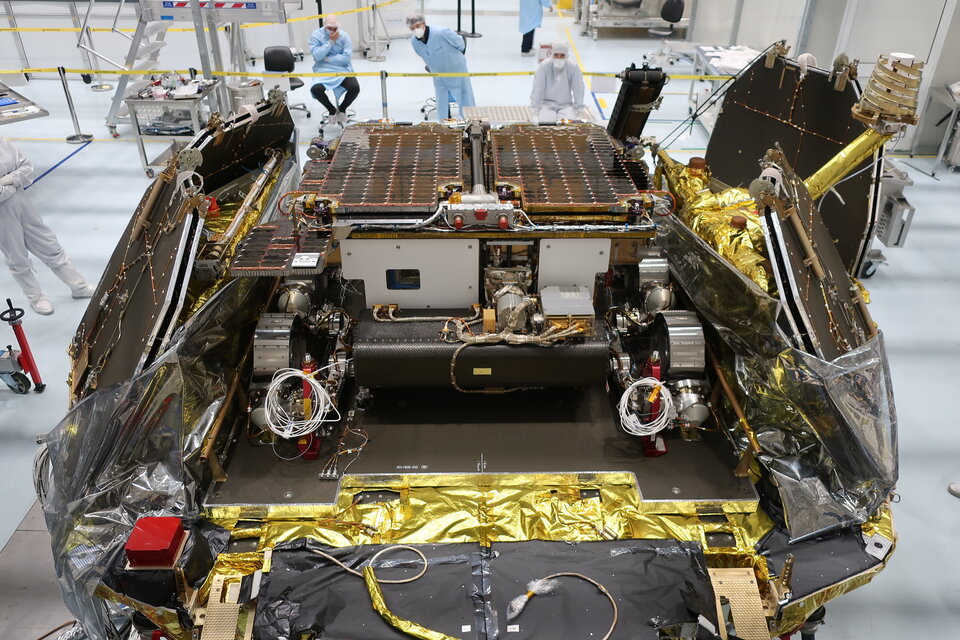
The effort to arrive at the starting line in time has been extraordinary, with double shifts and no time for breaks in 2021 amidst COVID -19 pandemic disruptions.
“The cooperation between European and Russian industry, the coordination between space agencies and the work of the technical teams have been remarkable,” praises Pietro.
Teams have solved critical issues working in parallel, such as the parachute system and the descent module electronics, with enough margin for a launch in September 2022. Preparations for launch have started in Baikonur, and a dedicated support team is in place at ESOC centre in Darmstadt, Germany.
The ESA-Roscosmos Trace Gas Orbiter is waiting for the arrival of ExoMars to the Red Planet. In addition to its own science mission, the orbiter relays data from NASA’s Perseverance rover. Also on the martian surface since 2021 is China’s Zhurong rover.
“It’s not long to go before the European rover can finally join the other martian drivers in 2023 with a top class scientific laboratory on board,” says Pietro.
The ESA-Roscosmos ExoMars 2022 mission will launch on a Proton-M rocket with a Breeze-M upper stage from Baikonur, Kazakhstan, in the 20 September – 1 October 2022 launch window. A carrier module will transport the descent module with the Rosalind Franklin rover and Kazachok surface science platform inside, to Mars. Once landed safely in the Oxia Planum region of Mars on 10 June 2023, the rover will drive off the surface platform, seeking out geologically interesting sites to drill below the surface, to determine if life ever existed on our neighbour planet. The ExoMars programme also includes the Trace Gas Orbiter, which has been orbiting Mars since 2016. As well as its own science mission, Trace Gas Orbiter will provide essential data relay services for the surface mission.
In Europe, the rover is a joint venture between Thales Alenia Space and Leonardo. Thales is the industrial prime, Leonardo providing the drill, OHB the complex laboratory mechanisms and nine different instrument teams from ESA Member States, NASA/JPL and IKI/Roscosmos providing the payload. Airbus UK is responsible for the rover vehicle.
Quelle: ESA
